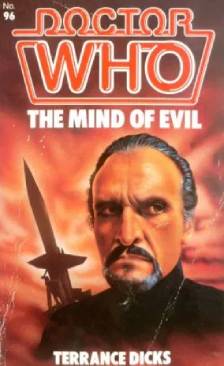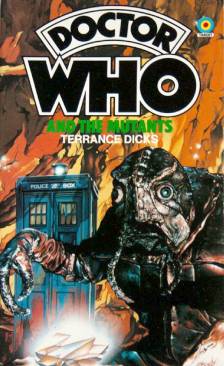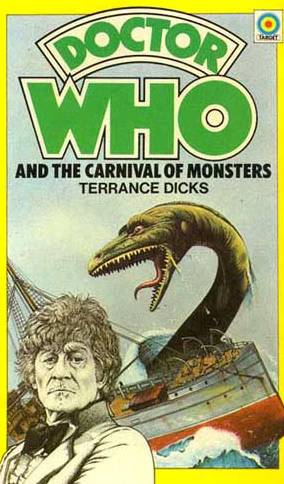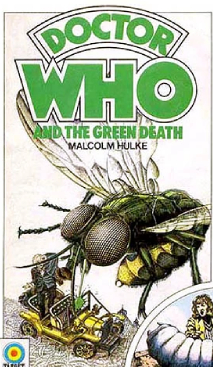
Synopsis: Experiments in a Cambridge laboratory have created instability in the web of time. The Master is using a trident-shaped crystal to summon Kronos, a creature from legend that ‘eats’ time itself. Recognising the origin of the crystal, the Doctor and Jo travel back to the time of Atlantis with the hope of stopping the Master but instead find themselves caught in his trap. When Kronos finally arrives, however, it is the Master who has to plead for his life…
Chapter Titles
- 1. The Nightmare
- 2. The Test
- 3. The Summoning
- 4. The Ageing
- 5. The Legend
- 6. The Ambush
- 7. The High Priest
- 8. The Secret
- 9. Time Attack
- 10. Take-Off
- 11. The Time-Eater
- 12. Atlantis
- 13. The Guardian
- 14. The Captives
- 15. The Return of Kronos
Background: Terrance Dicks adapts Robert Sloman’s scripts for the 1972 serial, completing the run of stories from Season 9 in Target’s library.
Notes: Professor Thascalos (not ‘Thascales’) is…:
… a medium-sized, compactly but powerfully built man, this Professor Thascalos, with sallow skin and a neatly-trimmed pointed beard. His dark burning eyes radiated energy and power.
A familiar description, but it’s not until he hypnotises Doctor Charles Perceval (not ‘Percival’) that Thascalos is revealed to be the Master. Percival’s predecessor was ‘over-fond of the bottle’ and so ‘an easy man [for the Master] to impress and to deceive’. The Master’s TOMTIT apparatus recreates ‘the powers of the legendary Timescoop of the Time Lords, forbidden by Rassilon in the Dark Time’, something only revealed eleven years later (or three years ago in book terms) in The Five Doctors.
The Doctor’s TARDIS sniffer-outer’ is ‘rather like a table tennis bat’ (it looks a lot ruder on telly!). Young Atlantean councillor Miseus is renamed ‘Myseus’. Perceval is accidentally confused with Humphrey Cook when he’s called ‘Humphrey Perceval’ seconds before his final moments. Weirdly, Dicks references the new TARDIS control room design and why we don’t see it again, as Jo notes that ‘from time to time, the Doctor altered some detail of the TARDIS interior. More often than not he decided he didn’t like what he’d done and reverted to the original.’ After the Master has captured Jo and disappeared in his TARDIS, Queen Galleia frees the Doctor and admits that she was wrong to trust the Master, just as she accepts that the people of Atlantis cannot be saved.
Cover: Andrew Skilleter paints a multilayered piece depicting the female eyes of Kronos, the winged Kronos creature and the trident crystal. It might be my favourite Skilleter cover.
Final Analysis: In the 1990s, when the Pertwee backlash was in full swing in some fanzines, The Time Monster came in for a particularly hard time. Compared to the Master’s previous exploits, it feels a little lightweight and it suffers from wading in the same pool as The Daemons, which concluded the previous season. There are ancient myths, the Master posing as a member of a community and resurrecting a godlike being. Sadly, we also get a load of nonsense with the Doctor balancing house-hold rubbish on a wine bottle before playing matador with a real, live minotaur, while the whole narrative purpose of UNIT seems a long way from its origins as an organisation investigating serious alien threats to Earth. The Brigadier is particularly dim while Benton’s reward for being the only member of UNIT with any brains is to be left standing before his peers in a nappy.
I’m not here to review the TV stories of course, but it’s difficult to avoid doing so when the book sticks so closely to the transmitted version. All of these excesses are present and correct in this book and, for once, Terrance Dicks’ methodical approach doesn’t work quite so well. It can be summed up by this underwhelming description of the final destruction of the TOMTIT machine:
… the result was nothing more serious than a loud bang, a shower of sparks and a lot of smoke.
Just one other observation: In the descriptions, the Brigadier’s number two is ‘Captain Yates’ or ‘Mike Yates’, but never ‘Mike’. Always the full name.









